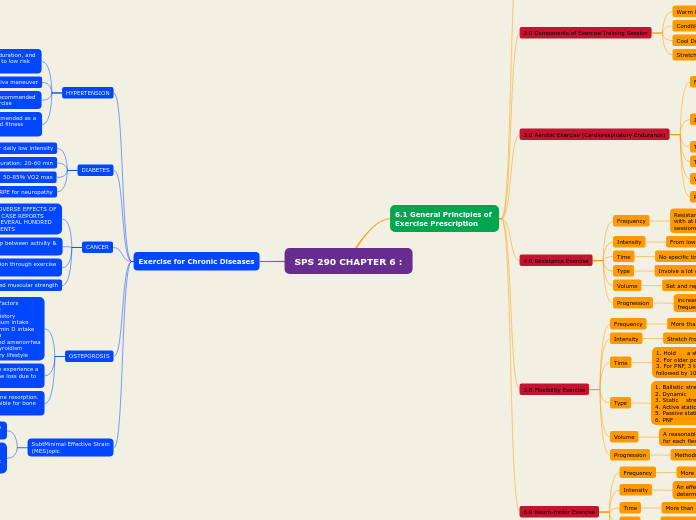SPS 290 CHAPTER 6 :
Exercise for Chronic Diseases
SubtMinimal Effective Strain
(MES)opic
Water exercise is appropriate when
multiple vertebral fractures are present or
back pain precludes participation in weight
bearing exercise
Force must meet or exceed the MES to
initiate new bone formation
OSTEPOROSIS
Osteoclasts promote bone resorption.
Osteoblasts are responsible for bone
deposition
Post menopausal women experience a
rapid acceleration of bone loss due to
estrogen deficiency
Key Risk Factors
- smoking
- family history
- low calcium intake
- low vitamin D intake
- anorexia
- prolonged amenorrhea
- hyperthyroidism
- sedentary lifestyle
CANCER
Increased muscular strength
cancer rehabilitation through exercise
prescription
strong inverse relationship between activity &
all cancer
NO MAJOR ADVERSE EFFECTS OF
EXERCISE IN CASE REPORTS
INVOLVING SEVERAL HUNDRED
CANCER PATIENTS
DIABETES
May use RPE for neuropathy
Intensity: 50-85% VO2 max
Duration: 20-60 min
Frequency: 4-6 day per week or daily low intensity
HYPERTENSION
Resistance training is recommended as a
component of a well rounded fitness
program
Resistance training is not recommended
as the primary form of exercise
Avoid valsalva maneuver
Exercise mode, frequency, duration, and
intensity of exercise similar to low risk
individuals
6.1 General Principles of
Exercise Prescription
6.0 Neuro-motor Exercise
Methods for optimal progression are not known
The optimal volume
Involving motor skills
More than 20 to 30 mins per day is needed
An effective intensity of neuromotor exercise has not been determined
More than 2 to 3 days per week is recommended
5.0 Flexibility Exercise
Methods for optimal progression are unknown
A reasonable target is to perform 60 s of total stretching time for each flexibility exercise
1. Ballistic stretching
2. Dynamic stretching
3. Static stretching
4. Active static stretching
5. Passive static stretching
6. PNF
1. Hold a static stretch for 10 to 30 second for adults
2. For older populations hold for 30 to 60 seconds
3. For PNF, 3 to 6 seconds of max voluntary contraction followed by 10 to 30 seconds assisted stretching
Stretch from the discomfort point
More than 2-3 days per week
4.0 Resistance Exercise
increasing
frequency is recommended
Set and repetitions
Involve a lot of body muscle
No specific time
From low to high intensity
Resistance training of each muscle group 2-3days per week with at least 48 hours separating the exercise training sessions for same muscle groups
3.0 Aerobic Exercise (Cardiorespiratory Endurance)
Progression
The progress of the exercise is depends on the individual goals
Volume
The volume is the product from the frequency, intensity and the time of exercise
Type
The type of the exercise need to suitable for the age category
Time
Adults should accumulate 30-60mins per day
Intensity
1. Moderate(40% to 60% of HRR or Vo2 Reserve)for healthy adults
2. Vigorous (60% to 90% of HRR and Vo2 Reserve) for healthy adults
3. Light(30% to 40% of HRR and Vo2 Reserve)
Frequency
1. Moderate intensity, aerobic exercise done at least 5 days per week
2. Vigorous intensity, aerobic exercise done at least 3 days per week
2.0 Components of Exercise Training Session
Stretching
Cool Down
Conditioning
Warm Up
1.0 Introduction on Principle of Exercise Prescription
a) Beginning a new program of exercise at light-to�moderate intensity
b) Employing a gradual progression of the quantity
and quality of exercise
c) Following the pre-participation health screening
and evaluation procedures
Principles of Exercise Prescription includes:
i. F – Frequency (how often)
ii. I – Intensity (how hard)
iii. T – Time (how long)
iv. T – Type (mode or what type of exercise)
v. V – Volume (amount)
vi. P – Progression (advancement)
An exercise training program ideally is designed to
meet individual health and physical fitness goals.

